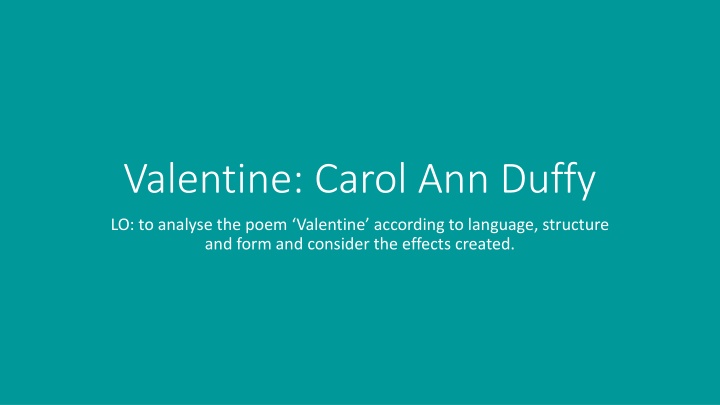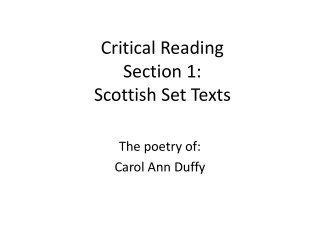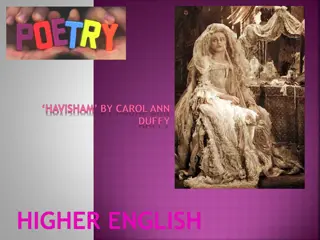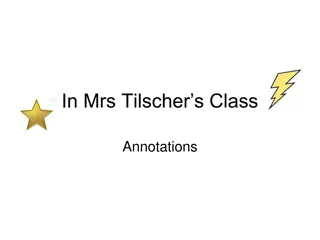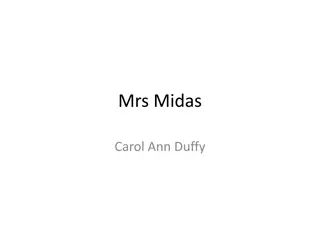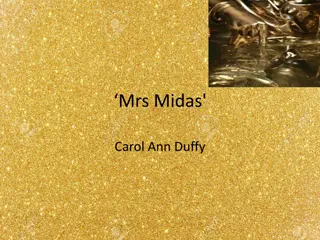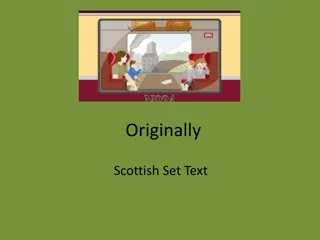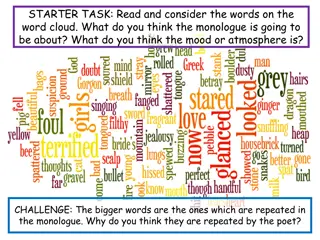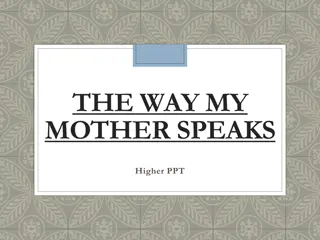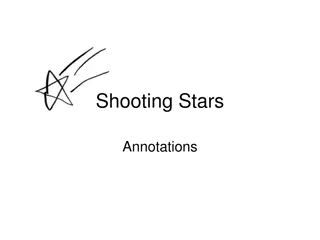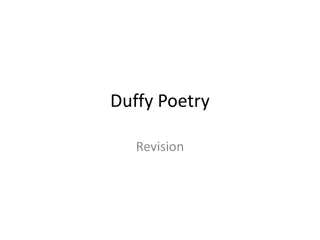Analysis of "Valentine" by Carol Ann Duffy: Language, Structure, and Form
In "Valentine" by Carol Ann Duffy, the unconventional form with irregular stanzas and single-word lines creates a disjointed effect, emphasizing the forceful tone. The structure builds on the layers of an onion as a metaphor for love, gradually revealing the poem's meaning. The language uses an extended metaphor of the onion to symbolize love, coupled with direct address and dangerous undertones, challenging traditional notions of romance. Themes of love, honesty, and danger are explored, subverting clichéd symbols. The poem's unique approach prompts reflection on the complexities of relationships and the darker aspects of love.
Download Presentation

Please find below an Image/Link to download the presentation.
The content on the website is provided AS IS for your information and personal use only. It may not be sold, licensed, or shared on other websites without obtaining consent from the author.If you encounter any issues during the download, it is possible that the publisher has removed the file from their server.
You are allowed to download the files provided on this website for personal or commercial use, subject to the condition that they are used lawfully. All files are the property of their respective owners.
The content on the website is provided AS IS for your information and personal use only. It may not be sold, licensed, or shared on other websites without obtaining consent from the author.
E N D
Presentation Transcript
Valentine: Carol Ann Duffy LO: to analyse the poem Valentine according to language, structure and form and consider the effects created.
Form: Different to traditional love poems, Duffy s poem is written in stanzas of irregular lengths, several of only one line, which makes the poem seem disjointed. Some lines are made up of single words, which gives emphasis to the forceful tone to the reader. Activity 1: In your exercise books, write down examples of form.
Structure: The poem is in a list of the ways an onion symbolizes love. Words and ideas are built-up and repeated throughout the poem. This could mirror the different layers of an onion, as the poem s meaning is revealed gradually. The tone is initially quite playful, but the speaker s insistence that their partner accepts the gift could be read as encouraging or confrontational. Activity 2: Write down evidence to prove the point I ve made on tone.
Language: Extended Metaphor: The extended metaphor of the onion is used to represent love. The speaker sees the onion as a honest symbol- it symbolises joy and intimacy of love, but also the pain it brings. It is an unusual metaphor, which contrasts with the more stereotypical romantic symbols of love, like roses and cards. Direct Address: The poem is written in first person and directly addresses an unknown partner as you - it is very personal. The speaker uses commands like _____________ , which may be seen as forceful. Dangerous Language: There s an unusual amount of negative language for a love poem. Words like blind , fierce and Lethal have a dark undertone. The speaker implies that this is a possessive relationship, while the word knife at the end hints that it might be dangerous.
Themes: Love: The poet explores different forms of love. Love can be physical or emotional. It can be fierce and possessive and cause pain. There are also references to marriage and being faithful. Honesty: The speaker takes pride in being honest about love. They suggest that the traditional images of love, like red roses and cute cards don t say anything real about love. Danger: At the end of the poem, there is a growing sense of danger, although it is only implied.
Valentine: Immediately clear this is not a traditional love poem. Stereotypical symbols of love. The speaker implies these are cliched and lack meaning. Not a red rose or a satin heart.
Valentine: stanza 2 Introduces the gift of an onion, which becomes an extended metaphor for love. It s an unexpected contrast with the first line. The moon is a traditional symbol of love and fertility. Personal pronouns highlight that this poem is for a specific person. This emphasises that the onion is a plain, unsentimental gift. I give you an onion. It is a moon wrapped in brown paper. It promises light like the careful undressing of love. Enjambment breaks these similes up, making the poem feel disjointed. The separation also emphasises how unpredictable the similes are- the comparisons don t necessarily end in the way the reader expects. Hints at sexual love and physical intimacy.
Valentine: stanza 3 The onion symbolises the way love can cause pain. Language like blind and grief is strongly negative unlike traditional Valentine s Day messages. The use of It makes it unclear whether the speaker means the onion or love itself. Here. It will blind you with tears like a lover. It will make your reflection a wobbling photo of grief. Enjambment breaks these similes up, making the poem feel disjointed. The separation also emphasises how unpredictable the similes are- the comparisons don t necessarily end in the way the reader expects.
Valentine: stanza 4 This line is unconnected to any others and almost divides the poem in two. It could represent the heart of the poem- the speaker is trying to find the true meaning of love. I am trying to be truthful.
Valentine: stanza 5 Alliteration makes these seem overtly sentimental and makes the reader seem disdainful of them. Not a cute card of kissogram.
Valentine: stanza 6 This repeated line presents the speaker as insistent and forceful, establishing a sense of unease. I give you an onion. Its fierce kiss will stay on your lips, possessive and faithful as we are, for as long as we are. Love is described in physical terms. There s also a suggestion that it can be dangerous and possessive Echoes the wedding vow For as long as we shall live.
Valentine: stanza 7 The offer of an onion in line 6 changes to a command. The speaker could be merely encouraging their lover to accept the gift, or their tone may be interpreted as confrontational, which makes the mood darker. By placing Lethal alone on an end- stopped line, the speaker emphasises the idea that the onion symbolises danger and death. This is shocking and unexpected in a love poem. Reference to a wedding ring could be a proposal. It s undermined by the sense of hesitation in the next line. Take it. Its platinum looks shrink to a wedding ring, if you like. Lethal. Its scent will cling to your fingers, cling to your knife. The repetition of cling on two lines emphasises the inescapability of its scent . The word also has a dark double meaning- it hints love can be possessive and suffocating. A powerful, disturbing final image. There s a hint that it refers to something more sinister than chopping an onion but exactly what is left unsaid. It implies that love has the power to wound.
Comparisons? My Last Duchess Sonnet 43
Assessment Question: How does the poet portray relationships in the poem?
